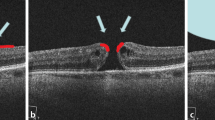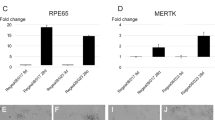Abstract
• Purpose: Retinal glia may play an important role in the closure of macular holes. This in vitro study examines whether and how the specific pathoanatomy, including foveal eversion and foveal vitreous, may interfere with glial closure of macular holes. • Methods: Culture dishes used to grow glial cells were modified by the placement of slopes, vertical steps, and gaps to mimic the in vivo migratory surface in and surrounding macular holes. In separate experiments, defects were made in a rodent glial monolayer. These defects were exposed to hyaluronic acid (HA) and to rabbit (RV) and bovine (BV) vitreous gel. The migratory behavior and completeness of closure of defects were compared to controls. • Results: As expected, glial cells migrated further and in greater numbers on a smooth surface. Slopes and steps were mode-rate obstacles to migration; gaps in the surface were absolute obstacles. HA modified the pattern of adhesion of cells at the bottom of defects. Defects in the glial monolayer were repaired in 5–7 days. Compared to these controls, repair was inhibited by 11 % (n. s.), 28% (P=0.02), and 58% (P=0.004) after direct exposure of defects to HA, RV and BV respectively. • Conclusion: The elevated and everted margins of macular holes represent slope, step, and gap-like obstacles to the migration of glial cells and hence to the healing of defects. The defect allows extension of extracellular matrix into it and the subretinal space. Our results indicate that gaps in the migratory surface caused and aggravated by eversion and the presence of vitreous present obstacles to glial migration and closure of macular holes.
Similar content being viewed by others
References
Balazs EA, Darzynkiewicz Z (1973) The effect of hyaluronic acid on fibroblasts, mononuclear phagocytes and lymphocytes. In: Kulonen E, Pikkarainen J (eds) Biology of the fibroblast. Papers of the symposium held in Turku, Finland, 1972. Academic, London, pp 237–252
Balazs EA, Denlinger JL (1984) The vitreous. In: Davson H (ed) The eye, 3rd edn. Academic, New York, pp 533–589
Byer NE (1982) The natural history of asymptomatic retinal breaks. Ophthalmology 80:1033–1039
Dunnington JH (1951) Healing of incisions for cataract extraction. Am J Ophthalmol 34:36–45
Eisner G (1986) Ophthalmic viscosurgery. A review of standards, techniques and applications. Medicoepea, Montreal
Frangieh G, Green W, Engel H (1981) A histopathologic study of macular cysts and holes. Retina 1:311–336
Funata M, Wendel RT, de la Cruz Z, Green RW (1992) Clinicopathologic study of bilateral macular holes treated with pars plana vitrectomy and gas tamponade. Retina 12:289–298
Glaser B, Michels R, Kupperman B, Sjaarda R, Pena R (1992) Transforming growth factor beta 2 for the treatment of full-thickness macular holes. Ophthalmology 99:1162–1173
Gonin J (1934) Decollement de la retine. Librairie Payot, Lausanne
Guerin CJ, Wolfshagen RW, Eifrig DE, Anderson DH (1990) Immunocytochemical identification of Mueller's glia as a component of human epiretinal membranes. Invest Ophthalmol Vis Sci 31:1483–1491
Guyer D, Green W, de Bustros S, Fine S (1990) Histopathologic features of idiopathic macular holes and cysts. Ophthalmology 97:1045–1051
Head M, Corbin E, Goldman J (1994) Coordinate and independent regulation of alpha B-crystallin and HSP27 expression in response to physiological stress. J Cell Physiol 159:41–50
Hogan MJ, Alvarado JA, Weddell JE (1971) Histology of the human eye. Saunders, Philadelphia
Johnson RN, Gass JDM (1988) Idiopathic macular holes. Observations, stages of formation, and implications for surgical intervention. Ophthalmology 95:917–924
Kelly NE, Wendel RT (1991) Vitreous surgery for idiopathic macular holes. Results of a pilot study. Arch Ophthalmol 109:654–659
Kirchhoff B, Orr G, Ryan SJ, Lean JS (1986) The role of the vitreous and the retina in controlling the transfer of tritiated water from the vitreous cavity to the choroid. Invest Ophthalmol Vis Sci [Suppl] 27:316
Krebs W, Krebs I (1989) Quantitative morphology of the central fovea in the primate retina. Am J Anat 184:225–236
Lewis H, Cowan GM, Straatsma BR (1986) Apparent disappearance of a macular hole associated with development of an epiretinal membrane. Am J Ophthalmol 102:172–175
Madreperla SA, Geiger GL, Funata M, de la Cruz Z, Green WR (1994) Clinicopathologic correlation of a macular hole treated by cortical vitreous peeling and gas temponade. Ophthalmology 101:682–686
Madreperla SA, McCuen BW, Hickingbotham D, Green WR (1995) Clinicopathologic correlation of surgically removed macular hole opercula. Am J Ophthalmol 120:197–207
Mann IC (1928) The development of the human eye. Cambridge University Press, London, p 81
Nao-i N, Nakano T, Sawada A, Ogino N, Tachi N (1996) Effect of removal of the retina] pigment epithelium on postoperative visual recovery after vitrectomy for idiopathic macular holes. Invest Ophthalmol Vis Sci [Suppl] 37:428
Orellana J, Lieberman RM (1993) Stage 3 macular hole surgery. Br J Ophthalmol 77:555–558
Rice RT (1994) Success in macular hole surgery is increased by removal of presumed internal limiting membrane. Annual meeting of the Retina Society, Williamsburg, Virginia, p 61
Thompson JT, Smiddy WE, Glaser BM, Sjaarda RN, Flynn HW (1996) Intraocular tamponade duration and success of macular hole surgery. Retina 16:373–382
Weinberger D, Sticbel H, Gaton DD, Priel E, Yassur Y (1995) Three-dimensional measurements of idiopathic macular holes using a scanning laser tomograph. Ophthalmology 102:1445–1449
Yamada E (1969) Some structural features of the fovea centralis in the human retina. Arch Ophthalmol 82:151–159
Yanoff M, Fine BS (1982) Ocular pathology: a text and atlas, 2nd edn. Harper & Row, Philadelphia
Author information
Authors and Affiliations
Rights and permissions
About this article
Cite this article
Schubert, H.D., Kuang, K., Kang, F. et al. Macular holes: migratory gaps and vitreous as obstacles to glial closure. Graefe's Arch Clin Exp Ophthalmol 235, 523–529 (1997). https://doi.org/10.1007/BF00947011
Received:
Revised:
Accepted:
Issue Date:
DOI: https://doi.org/10.1007/BF00947011




